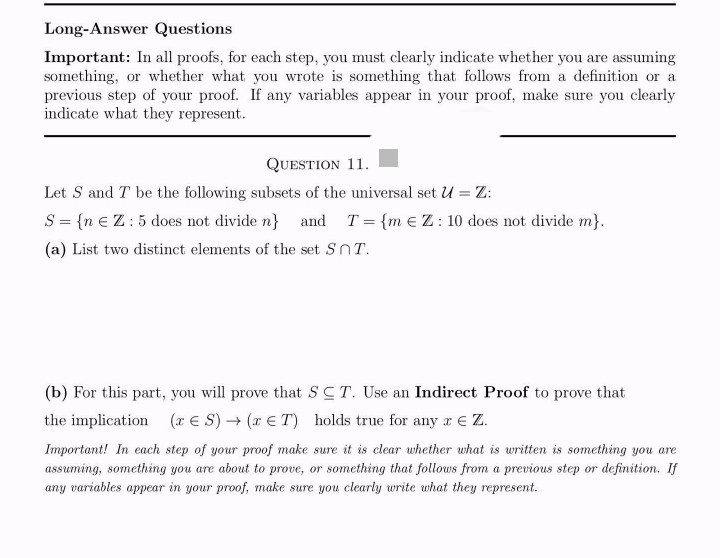QUESTION 11. Let S and T be the following subsets of the universal set U = Z: S = {n € Z: 5 does not divide n} and T = {m € Z: 10 does not divide m}. (a) List two distinct elements of the set SnT. (b) For this part, you will prove that SCT. Use an Indirect Proof to prove that the implication (ES) → (ET) holds true for any z € Z.
QUESTION 11. Let S and T be the following subsets of the universal set U = Z: S = {n € Z: 5 does not divide n} and T = {m € Z: 10 does not divide m}. (a) List two distinct elements of the set SnT. (b) For this part, you will prove that SCT. Use an Indirect Proof to prove that the implication (ES) → (ET) holds true for any z € Z.
Advanced Engineering Mathematics
10th Edition
ISBN:9780470458365
Author:Erwin Kreyszig
Publisher:Erwin Kreyszig
Chapter2: Second-order Linear Odes
Section: Chapter Questions
Problem 1RQ
Related questions
Question
I need explanation of answer how u find and what is the answer
I need explanation so plz solve and provide me detailed solution

Transcribed Image Text:Long-Answer Questions
Important: In all proofs, for each step, you must clearly indicate whether you are assuming
something, or whether what you wrote is something that follows from a definition or a
previous step of your proof. If any variables appear in your proof, make sure you clearly
indicate what they represent.
QUESTION 11.
Let S and T be the following subsets of the universal set U = Z:
S = {n € Z: 5 does not divide n} and T = {m EZ: 10 does not divide m}.
(a) List two distinct elements of the set SnT.
(b) For this part, you will prove that SCT. Use an Indirect Proof to prove that
the implication (ES) → (x T) holds true for any a x € Z.
Important! In each step of your proof make sure it is clear whether what is written is something you are
assuming, something you are about to prove, or something that follows from a previous step or definition. If
any variables appear in your proof, make sure you clearly write what they represent.
Expert Solution
This question has been solved!
Explore an expertly crafted, step-by-step solution for a thorough understanding of key concepts.
Step by step
Solved in 3 steps with 3 images

Recommended textbooks for you

Advanced Engineering Mathematics
Advanced Math
ISBN:
9780470458365
Author:
Erwin Kreyszig
Publisher:
Wiley, John & Sons, Incorporated

Numerical Methods for Engineers
Advanced Math
ISBN:
9780073397924
Author:
Steven C. Chapra Dr., Raymond P. Canale
Publisher:
McGraw-Hill Education

Introductory Mathematics for Engineering Applicat…
Advanced Math
ISBN:
9781118141809
Author:
Nathan Klingbeil
Publisher:
WILEY

Advanced Engineering Mathematics
Advanced Math
ISBN:
9780470458365
Author:
Erwin Kreyszig
Publisher:
Wiley, John & Sons, Incorporated

Numerical Methods for Engineers
Advanced Math
ISBN:
9780073397924
Author:
Steven C. Chapra Dr., Raymond P. Canale
Publisher:
McGraw-Hill Education

Introductory Mathematics for Engineering Applicat…
Advanced Math
ISBN:
9781118141809
Author:
Nathan Klingbeil
Publisher:
WILEY

Mathematics For Machine Technology
Advanced Math
ISBN:
9781337798310
Author:
Peterson, John.
Publisher:
Cengage Learning,

